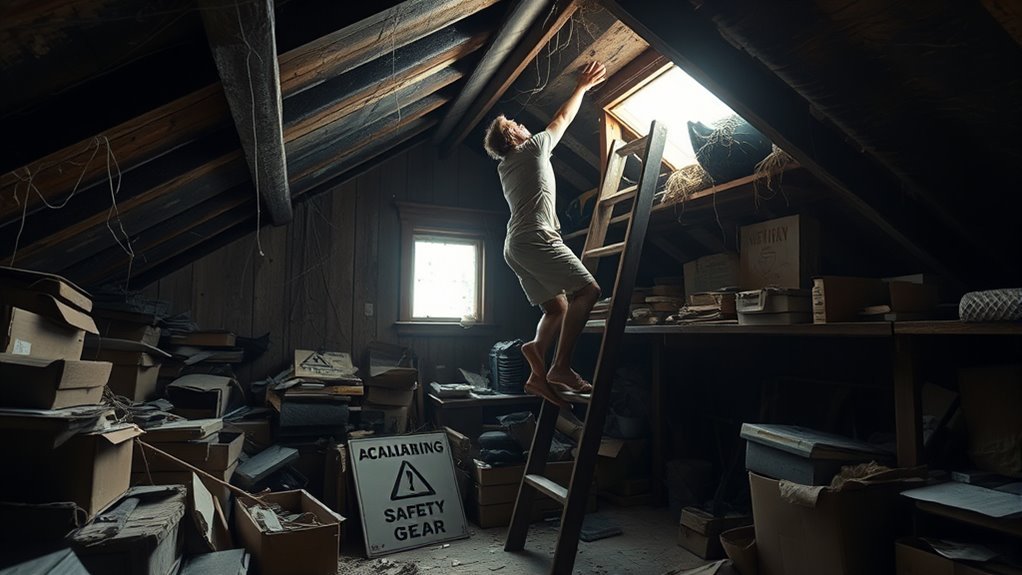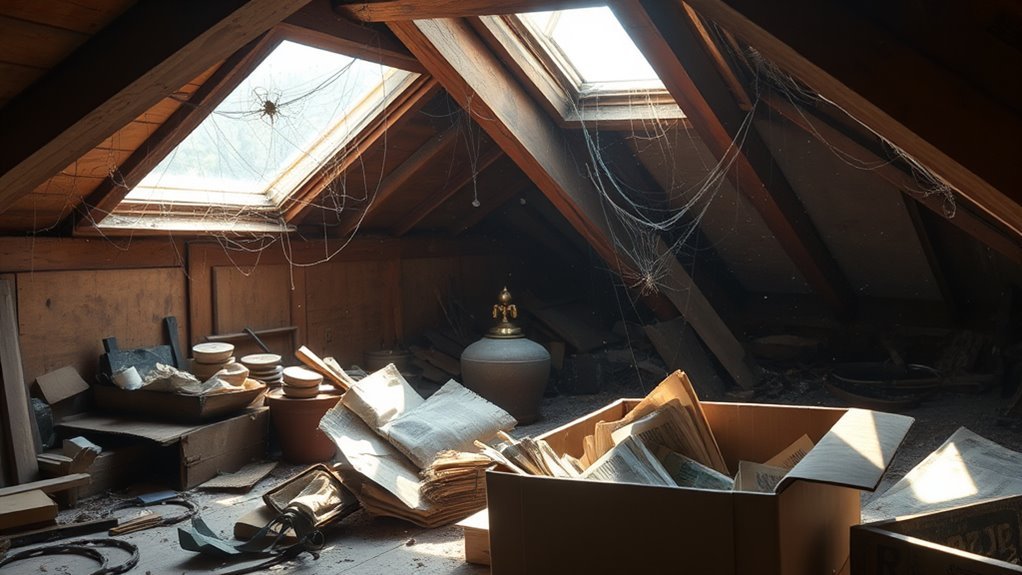Common Mistakes When Cleaning Attic
When cleaning your attic, don’t ignore safety precautions like wearing non-slip shoes or using fall protection. Always wear proper gear—respiratory masks, gloves, and eye protection—to avoid health risks from dust and insulation fibers. Check for electrical hazards by inspecting wiring and powering off circuits. Don’t overlook inspecting for pests or risk damaging insulation with improper tools. Proper debris disposal and ventilation are essential, as is maintaining structural integrity. Understanding these mistakes helps you clean more safely and effectively.
Ignoring Safety Precautions

While cleaning your attic, ignoring safety precautions can lead to serious injuries or health risks. You must prioritize using appropriate safety equipment to mitigate hazards such as sharp objects, unstable flooring, and airborne dust. Wear non-slip footwear and guarantee adequate lighting to prevent slips and trips. Fall protection is essential when accessing raised areas or working near openings; use harnesses or guardrails as necessary. Inspect ladders to confirm stability before climbing. Ventilation is also critical to avoid inhaling harmful particles. By adhering strictly to safety protocols and employing the correct equipment, you maintain your freedom to work efficiently while minimizing risk. Taking these preventative measures guarantees your attic cleaning task remains safe and controlled, protecting you from avoidable accidents or health complications.
Failing to Wear Proper Protective Gear
You shouldn’t skip wearing a respiratory mask since attic dust often contains harmful particles like mold and asbestos. Protective clothing is essential to prevent skin irritation and contact with contaminants. Don’t forget eye protection and gloves to guard against debris and sharp materials during cleanup.
Importance of Respiratory Masks
Although the attic may seem harmless, neglecting to wear a respiratory mask exposes you to harmful dust, mold spores, and insulation fibers that can cause serious respiratory issues. Protecting your respiratory health is essential, as airborne contaminants in attic spaces greatly degrade air quality. A properly fitted mask, such as an N95 respirator, filters out fine particulates and biological hazards, preventing inhalation that could trigger allergies, asthma, or long-term lung damage. Without this protection, you risk compromising your freedom to breathe cleanly and safely. Prioritize selecting masks certified for particle filtration and guarantee a secure fit to maintain a controlled breathing environment. By doing so, you uphold both personal well-being and the integrity of the attic cleaning process.
Protective Clothing Necessity
Three essential types of protective clothing are necessary to guarantee safety during attic cleaning: gloves, coveralls, and eye protection. Neglecting these protective clothing types increases exposure to hazardous dust, insulation fibers, and chemical residues. Choosing appropriate cleaning material choices, such as disposable coveralls made of non-woven fabric, guarantees effective barrier protection while allowing mobility. Gloves must be durable and chemical-resistant to prevent skin irritation or injury. While eye protection will be addressed separately, be mindful that these clothing choices collectively prevent contamination and physical harm. Skipping proper gear compromises your freedom to work confidently and safely. Prioritize these protective clothing types to maintain both personal safety and cleaning efficiency, avoiding common mistakes that stem from underestimating attic hazards and material dangers.
Eye and Hand Protection
Alongside selecting the right gloves and coveralls, protecting your eyes and hands with proper gear is essential to avoid injuries and contamination during attic cleaning. Eye protection, such as safety goggles or sealed glasses, shields your eyes from dust, insulation fibers, and airborne particles that can cause irritation or long-term damage. For hand safety, durable gloves resistant to punctures and chemical exposure are vital, especially when handling sharp objects or hazardous materials. Neglecting these protections increases the risk of cuts, infections, and exposure to harmful substances like mold or rodent droppings. By consistently using certified eye protection and appropriate gloves, you maintain control over your environment and safeguard your freedom to work safely and efficiently in confined attic spaces. Don’t compromise on gear—you’re protecting your most valuable tools: your eyes and hands.
Overlooking Electrical Wiring Hazards
When cleaning your attic, you need to be vigilant about electrical wiring hazards, as damaged or exposed wires can pose severe risks such as electrical shocks or fires. Prioritize electrical safety by conducting a thorough wiring inspection before starting any cleaning tasks. Look for frayed insulation, loose connections, or signs of overheating. Avoid touching any wires directly and guarantee the power is turned off if you must work near electrical components. Using a non-contact voltage tester can help identify live wires safely. Neglecting this step can lead to accidental electrocution or spark a fire, compromising your freedom to maintain your home safely. Always consider consulting a licensed electrician if you detect any irregularities during your wiring inspection to guarantee your attic environment remains secure.
Neglecting to Inspect for Pests

After ensuring your attic’s electrical wiring is safe, the next step is to inspect for pests that may have infested the space. Neglecting this can lead to structural damage or health hazards. Employ pest identification tips to recognize signs like droppings, nests, or gnaw marks. Implement pest prevention strategies such as sealing entry points and maintaining cleanliness to deter infestations.
| Pest Type | Identification Signs | Prevention Strategies |
|---|---|---|
| Rodents | Droppings, chewed wires | Seal gaps, set traps |
| Insects | Webs, shed skins | Use insecticides, eliminate moisture |
| Birds | Feathers, nests | Install netting, block openings |
| Bats | Guano, scratching sounds | Seal entry points, install bat houses |
Thorough inspection frees you from unseen pest problems, ensuring attic safety and longevity.
Damaging Insulation During Cleaning
Although insulation is essential for energy efficiency, it’s easy to damage it during attic cleaning if you’re not careful. Different insulation types—fiberglass, cellulose, spray foam—require tailored cleaning methods to maintain their integrity. To avoid damage, keep these points in mind:
- Avoid aggressive brushing or vacuuming that can dislodge or compact loose-fill insulation.
- Refrain from using water or damp cloths on cellulose insulation, as moisture reduces its effectiveness.
- Steer clear of compressing insulation with heavy foot traffic, which reduces thermal performance.
- Make certain any debris removal is done gently to prevent tearing or shifting of batt insulation.
Using Inappropriate Cleaning Tools

Since attic spaces often contain delicate materials and tight areas, using inappropriate cleaning tools can cause significant damage or reduce the effectiveness of insulation and structural components. When selecting cleaning supplies, you need to prioritize tools designed for confined, sensitive environments. Avoid abrasive brushes or heavy-duty vacuums that can tear insulation or disrupt wiring. Instead, opt for soft-bristled brushes, microfiber cloths, and vacuums with adjustable suction settings. Proper tool selection guarantees you clean thoroughly without compromising attic integrity. Additionally, consider lightweight, ergonomic tools to navigate cramped spaces comfortably, maintaining your freedom of movement. By carefully choosing cleaning supplies tailored to attic conditions, you prevent costly repairs and preserve the space’s functionality and energy efficiency. Always match your tools to the attic’s unique characteristics for the best results.
Ignoring Ventilation Needs
Proper attic ventilation is essential to maintain air quality, prevent moisture buildup, and regulate temperature. When cleaning your attic, don’t overlook the importance of a thorough ventilation assessment. Without proper air circulation, you risk mold growth, wood rot, and compromised insulation efficiency. To guarantee your attic stays healthy, focus on:
- Checking intake and exhaust vents for blockages
- Verifying balanced airflow to prevent hot or cold spots
- Evaluating vent placement to optimize air exchange
- Inspecting for signs of condensation or stale air
Disregarding Structural Integrity
When cleaning your attic, don’t overlook the importance of support beams—they’re critical for maintaining structural stability. You also need to be mindful of overloading floor joists, as excessive weight can compromise their integrity. Ignoring these factors increases the risk of damage or collapse during your cleaning process.
Ignoring Support Beams
Although it might seem like a minor detail, overlooking support beams during attic cleaning can compromise the entire structure’s integrity. You need to pay close attention to support beam placement and conduct a thorough structural assessment before proceeding. Ignoring these critical elements can lead to costly damage or safety hazards. Keep these points in mind:
- Identify all support beams and avoid placing weight or pressure on them.
- Inspect beams for signs of rot, cracks, or insect damage that could weaken their load-bearing capacity.
- Maintain clear access around support beams to prevent accidental impact or stress.
- Consult a professional if you notice any irregularities in beam alignment or condition.
Respecting support beams guarantees your attic remains structurally sound and safe for all future use.
Overloading Floor Joists
After verifying support beams are intact and undisturbed, attention must shift to the floor joists beneath your feet. These joists have specific floor weight limits that, if exceeded, risk structural failure. When cleaning or storing items in your attic, you need to be mindful not to overload these joists. Ignoring floor weight limits can cause sagging, cracks, or even collapse, compromising your home’s safety. If your attic will be used frequently or for heavy storage, consider attic reinforcement options such as sistering joists or adding cross bracing. Taking these steps preserves structural integrity and grants you freedom to utilize the space safely. Always consult with a structural professional before modifying joists to verify your attic remains both functional and secure.
Improper Disposal of Debris
Throwing out attic debris without following proper protocols can lead to environmental harm and safety hazards. Effective debris management requires you to understand specific disposal methods to protect your home and the environment. Here’s what you need to keep in mind:
- Separate hazardous materials like asbestos or mold-contaminated insulation for specialized disposal.
- Use sealed containers to prevent dust and fibers from spreading during removal.
- Avoid dumping debris in unauthorized locations to comply with local regulations.
- Contact local waste management services to identify approved disposal sites for construction waste.
Skipping Regular Maintenance Checks
You shouldn’t skip scheduled maintenance checks when cleaning your attic, as they’re essential for identifying structural issues and moisture build-up early. Neglecting these inspections increases the risk of costly damage and compromised insulation efficiency. Regular checks help maintain attic integrity and prevent long-term problems.
Importance of Scheduled Inspections
Although it may seem tedious, skipping regular attic maintenance checks can lead to overlooked issues such as moisture buildup, pest infestations, or structural damage. Scheduled inspections and regular assessments are essential to maintain your attic’s integrity and guarantee long-term freedom from costly repairs. When you commit to consistent evaluations, you’ll be able to:
- Detect early signs of water intrusion or mold growth
- Identify pest entry points before infestations worsen
- Assess insulation performance for energy efficiency
- Monitor structural elements for deterioration or damage
Risks of Neglecting Maintenance
Neglecting regular maintenance checks greatly increases the risk of undetected problems escalating into costly repairs. When you skip attic maintenance, issues like moisture buildup, pest infestations, or structural damage can silently worsen. Over time, these problems compromise insulation effectiveness, reduce energy efficiency, and may lead to mold growth, posing health risks. Ignoring routine inspections means you lose early detection opportunities, resulting in long term consequences that limit your home’s durability and your financial freedom. By staying proactive with scheduled attic maintenance, you guarantee small issues are addressed promptly, preventing expensive repairs and preserving your living environment. Remember, consistent upkeep not only protects your investment but also maintains the safety and comfort of your home for years to come.
Frequently Asked Questions
How Often Should I Deep Clean My Attic?
Balancing the desire for freedom with the necessity of order, you should deep clean your attic at least once a year to maintain ideal attic organization. While occasional surface cleaning might suffice, a thorough deep clean addresses dust, pests, and structural concerns that accumulate over time. Establishing a regular cleaning frequency prevents deterioration and preserves your attic’s utility, ensuring the space remains safe and accessible for your needs without restricting your freedom to use it as you please.
Can Attic Cleaning Improve Home Energy Efficiency?
Yes, attic cleaning can improve home energy efficiency by allowing you to properly inspect and maintain attic insulation. Removing debris and dust helps identify damaged or compressed insulation that reduces thermal performance. Pair attic cleaning with energy audits to pinpoint heat loss areas and optimize insulation placement. This approach guarantees your home maintains better temperature regulation, reducing energy consumption and utility costs while enhancing your control over your living environment.
What Are the Best Times of Year for Attic Cleaning?
They say, “Make hay while the sun shines,” and when it comes to attic cleaning, seasonal considerations are essential. The best times are spring and fall, when attic accessibility is ideal—temperatures are moderate, reducing discomfort and moisture issues. During these seasons, you avoid extreme heat or cold, which can hinder thorough cleaning and inspection. Planning your attic maintenance in these windows maximizes efficiency, ensuring your home stays energy-efficient and your space well-maintained.
How Do I Identify Mold in the Attic?
To identify mold in your attic, start with thorough mold detection during attic inspections. Look for discoloration, like black, green, or white patches on wood or insulation. Musty odors also signal mold presence. Use a flashlight to spot hidden areas, especially near vents or water leaks. For accuracy, consider moisture meters or professional air quality testing. Early detection guarantees you maintain your attic’s freedom from harmful contaminants.
Should I Hire a Professional for Attic Cleaning?
You should consider hiring a professional for attic cleaning if you want thorough attic organization and effective pest control. Professionals have the expertise to safely remove debris, mold, and pests, ensuring your attic remains functional and healthy. They use specialized equipment to access tight spaces and identify hidden issues, giving you peace of mind and freedom from potential hazards. DIY might save money but risks incomplete cleaning and safety concerns.






